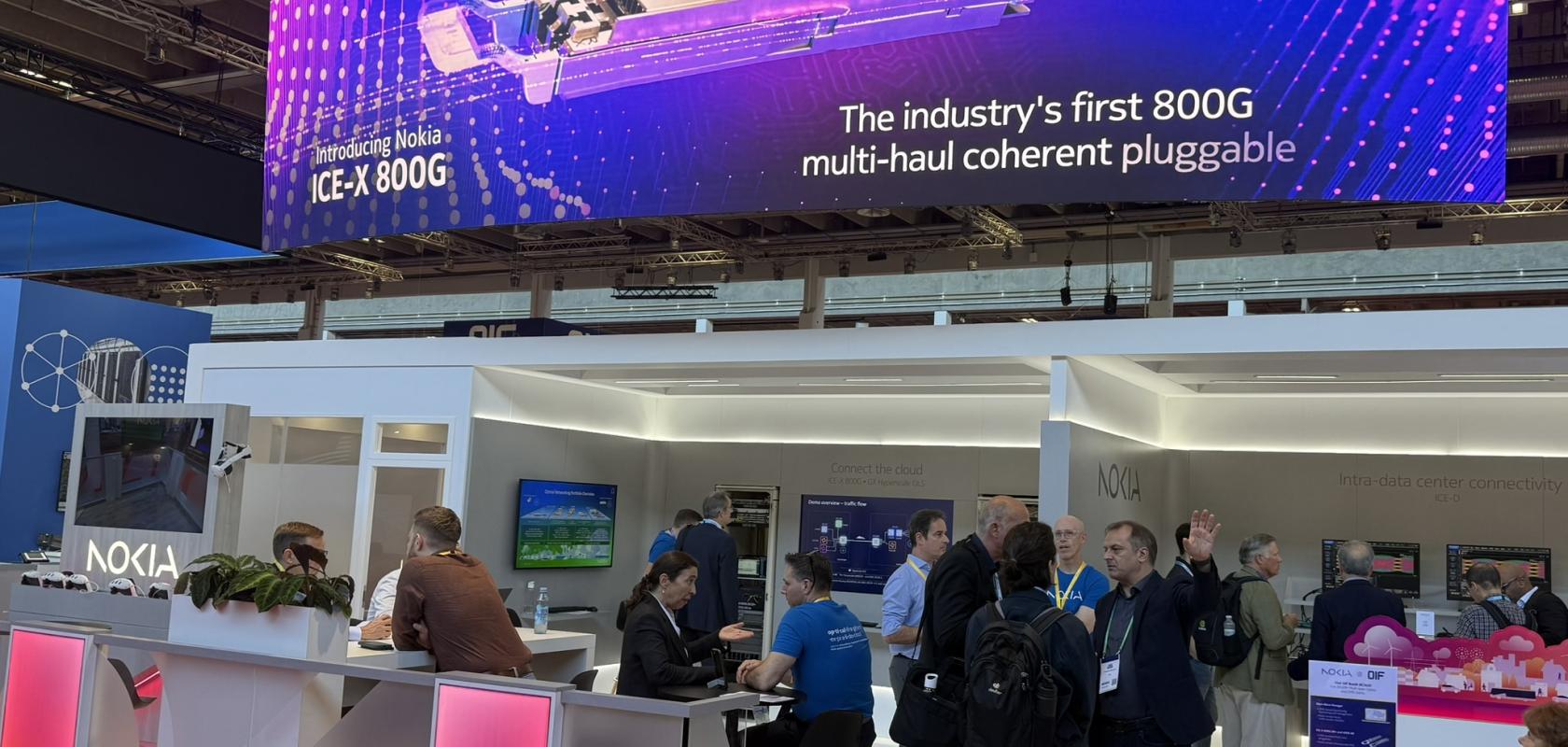At ECOC 2025, Nokia showcased two marquee solutions that pitch its focus for the future of optical networking: the ICE-X 800G intelligent coherent pluggable and a Hyperscale Open Line System (OLS). These innovations signal Nokia’s push deeper into next-generation data centre interconnect, metro/edge transport, and hyperscale network builds.
At the core of Nokia’s showcase at ECOC 2025, held in Copenhagen, Denmark, is the ICE-X 800G ZR/ZR+ pluggable transceiver family. Positioned as ‘the industry’s first multi-haul pluggable intelligent coherent transceiver (leveraging 3-nm CMOS and supporting interoperability) ICE-X is crafted to bring long-haul-capable performance in a low-power, pluggable form factor.
Smarter pluggable optics drive multi-haul flexibility
Some of the headlines include:
- Multi-haul reach: Nokia says ICE-X 800G can reach beyond 1,700km over standard SMF-28 fibre, while supporting lower bit-rate modes (e.g. 600G over 2,000km, 400G over 3,000km) to flex by link budget.
- Interoperability: It is designed to meet or exceed OIF 800ZR and 400ZR implementation agreements, support OpenZR+ Rev 3.0, and be interoperable in multi-vendor environments.
- Intelligent system-level features: Functions such as in-band management, streaming telemetry, remote diagnostic and troubleshooting helpers (e.g. loopbacks, demarcation) and embedded MACSec keying add depth beyond raw optics.
- Power & footprint efficiencies: In a compact QSFP-DD800 or OSFP form, ICE-X aims to shrink the cost, power, and space footprint of coherent transport, enabling smoother adoption, even in high-density environments.
It positions ICE-X as enabling flexible deployment in ‘multi-haul, multi-vendor interoperable’ architectures, allowing operators to address each application requirement with efficiency, flexibility, and lower total cost of ownership.
Technologically, ICE-X represents the convergence of advanced digital signal processing, compact front-ends, and intelligent module-level systems functions. The move toward 3-nm CMOS for DSPs, tighter integration with optics, and embedded network-awareness mirrors wider industry trends toward ‘smarter optics’ that blur the boundary between transport and control.
From a market standpoint, ICE-X is well timed. The demand for 800G coherent modules is accelerating: optical component market forecasts suggest that 800G datacom/transport shipments will grow more than 60% in 2025, with 400/800ZRx modules as a key driver. It’s clear operators are seeking optics that go beyond raw speed – emphasising power efficiency, flexibility, and simplified operations. ICE-X addresses that head-on.
Scaling simplicity: the Hyperscale Open Line System (OLS) for the AI era
Nokia is also pushing Hyperscale Open Line System (OLS) architecture at ECOC 2025, showcased via some neat augmented reality demos. This next-generation OLS is pitched as scaling fibre capacity without burdening operations.
Key aspects include:
- Operational simplicity: Nokia says its OLS evolution is as much about ease of use (autonomous control, automation, monitoring) as raw capacity.
- Massive scalability: The system is intended to support hyperscale ROADM and fiber expansion demands, enabling denser channel counts, broader optical spectrum use (e.g. C+L band) and approaching tens of terabits per fibre.
- Integrated intelligence/sensing: Nokia’s WaveSuite automation, integrated fibre sensing, stress detection, and classification tools help the OLS system dynamically adapt and expose hidden link characteristics.
Nokia is positioning this Hyperscale OLS as the spine that allows ICE-X and future pluggables to scale across metro and long haul with fewer manual touches, better visibility, and reduced TCO. Given the exponential rise in data traffic and AI workloads, networks must scale without multiplying complexity. Hyperscale OLS is a sensible assumption that operators will prioritise extensible, ‘low-touch’ systems over brute-force capacity gains.
Robert Shore, Head of Optical Networks Solution Market at Nokia, said the product would start to scale from 2026. From a market perspective, Nokia is positioning to challenge incumbents in the 800G pluggable space, and in hyperscale optical infrastructure, as the broader optics market undergoes renewed interest. The optical transport segment reportedly grew sharply in late 2024, and is exiting a past downturn. For pluggables, the move to 800G (and beyond to 1.6T) is rapidly gaining traction. Nokia’s ICE-X and OLS packages are clearly calibrated to ride that wave.
With the backdrop of its Infinera acquisition, Nokia is weaving these products into a larger narrative: that optical networks must be intelligent, automated, and seamlessly integrated to meet AI-era scale. As Shore puts it, the industry is not just demanding more capacity – but a broader portfolio of application-tailored optics. Nokia is placing its bet that ICE-X and Hyperscale OLS will be critical building blocks of that future.


